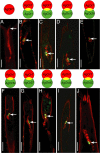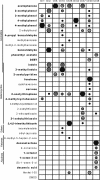The molecular and cellular basis of olfactory-driven behavior in Anopheles gambiae larvae
- PMID: 18427108
- PMCID: PMC2359781
- DOI: 10.1073/pnas.0801007105
The molecular and cellular basis of olfactory-driven behavior in Anopheles gambiae larvae
Abstract
The mosquito Anopheles gambiae is the principal Afrotropical vector for human malaria. A central component of its vectorial capacity is the ability to maintain sufficient populations of adults. During both adult and preadult (larval) stages, the mosquitoes depend on the ability to recognize and respond to chemical cues that mediate feeding and survival. In this study, we used a behavioral assay to identify a range of odorant-specific responses of An. gambiae larvae that are dependent on the integrity of the larval antennae. Parallel molecular analyses have identified a subset of the An. gambiae odorant receptors (AgOrs) that are localized to discrete neurons within the larval antennae and facilitate odor-evoked responses in Xenopus oocytes that are consistent with the larval behavioral spectrum. These studies shed light on chemosensory-driven behaviors and represent molecular and cellular characterization of olfactory processes in mosquito larvae. These advances may ultimately enhance the development of vector control strategies, targeting olfactory pathways in larval-stage mosquitoes to reduce the catastrophic effects of malaria and other diseases.
Conflict of interest statement
The authors declare no conflict of interest.
Figures




References
-
- Takken W, Knols BG. Odor-mediated behavior of Afrotropical malaria mosquitoes. Annu Rev Entomol. 1999;44:131–157. - PubMed
-
- Fillinger U, Sonye G, Killeen GF, Knols BG, Becker N. The practical importance of permanent and semipermanent habitats for controlling aquatic stages of Anopheles gambiae sensu lato mosquitoes: Operational observations from a rural town in western Kenya. Trop Med Int Health. 2004;9:1274–1289. - PubMed
-
- Fishilevich E, et al. Chemotaxis behavior mediated by single larval olfactory neurons in Drosophila. Curr Biol. 2005;15:2086–2096. - PubMed
Publication types
MeSH terms
Substances
Grants and funding
LinkOut - more resources
Full Text Sources
Other Literature Sources

